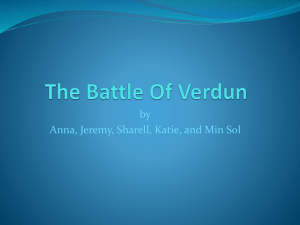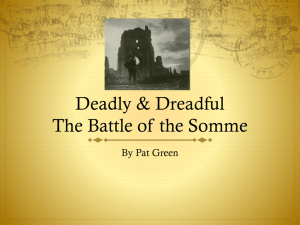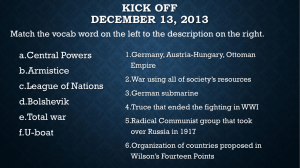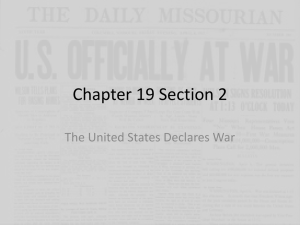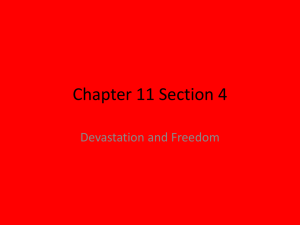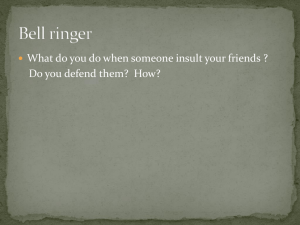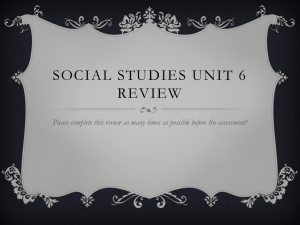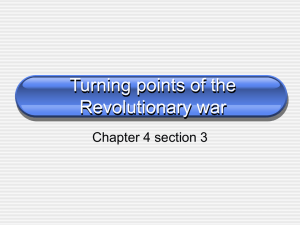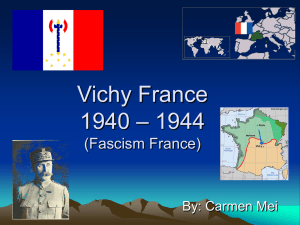The Battle of Verdun - shaunandmckenziewwiwiki
advertisement
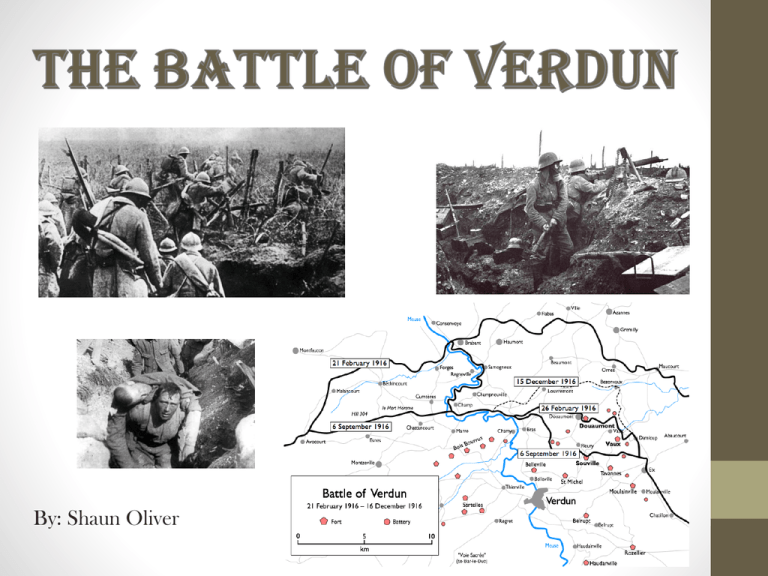
By: Shaun Oliver About The War • The battle began on February 21, 1916. • It was fought on the Western Front in France. • The battle was between France and Germany (Phillips and Axelrod). Forts Surrounding Verdun • When Germany attacked France, “it ran up against a ring of 18 large forts and 23 smaller strong points the French called ouvrages.” • During the 10 months in which the battle took place, two of the major forts, Douaumont and Vaux, fell. • Douaumont was the strongest and largest fort – taken without a shot being fired “virtually single-handedly by a German sergeant.” • When Vaux, the smallest fort in Verdun, was taken, the Germans lost 3,000 lives in 7 days (Zabecki). Facts About Verdun • Verdun “occupied a strategic blocking position in the Meuse River valley.” • Germany attacked France because they knew “it was still of great symbolic significance to France.” • Since there was a stalemate on the Western front, “the French would not willingly allow a German breakthrough at the ancient fortress.” • The German commander believed that by strongly and forcibly attacking this one point in France, the French would have no choice but to continue sending reinforcements. This would be their only option because if Germany took Verdun, they would have made a breakthrough and would then have an open pathway to Paris (Phillips and Axelrod). Leaders During The Battle • The German leaders were General Erich von Falkenhayn and Crown Prince Frederick William (Roberts). • Commander in chief of the French was Joseph Jacques Césaire Joffre (Phillips and Axelrod). • He replaced General Langle de Cary (who was in command of the Verdun defenses) with Henri Philippe Pétain (Phillips and Axelrod). Leaders Continued • Pétain was replaced at Verdun by Robert Nivelle. • Falkenhayn was eventually replaced by Erich Ludendorff and Paul von Hindenburg. • Shortly after this, Charles Mangin was brought in as the new commander at Verdun (Phillips and Axelrod). The First Attack • With the Fifth Army, the German Crown Prince was supposed to launch the first attack at Verdun (Phillips and Axelrod). • The prince wanted the assault to be on both sides of the Meuse River, “but the conservative Falkenhayn overruled him and ordered the attack to be confined to the east bank of the river” (Phillips and Axelrod). • “Their offensive was intended to cause so many French casualties that the French public would demand peace” (Battle of Verdun). Reinforcements • Due to bad weather, the operation was delayed and Joffre was able to be informed of the upcoming attack (Phillips and Axelrod). • This gave him time to call in reinforcements (Phillips and Axelrod). • “The French position was saved by the arrival of reinforcements under the command of Gen. Philippe Pétain” (Battle of Verdun). The French Battle Cry • Fort Douaumont fell to the Germans on February 25. • “Joffre responded with a promise to courtmartial any commander who voluntarily gave up ground.” • This was when he put Henri Philippe Pétain in charge of the German defenses. Pétain “pledged ‘Ils ne passeront pas!’— ‘They shall not pass!’ The phrase instantly became the battle cry of Verdun and, indeed, the French motto for the rest of the war” (Phillips and Axelrod). Henri Philippe Pétain • “Pétain was certainly willing to spend lives in the defense of Verdun, but he was also skilled at exacting tremendous casualties from the Germans as well.” • He “used artillery to bombard the German columns as they threaded forward through the steep, narrow valleys east of the Meuse.” • “Pétain also understood the crucial importance of keeping Verdun supplied with ammunition, provisions, and reinforcements” (Phillips and Axelrod). The Sacred Way • General Pétain designated a road named Bar-le-Duc that would be used to bring supplies to the French army at Verdun. • The road ran 50 miles westward. • A whole division “was assigned to repair the road continually, filling in shell craters as soon as they were made.” • Eventually the road was entitled Voie sacrée, which meant The Sacred Way (Phillips and Axelrod). The New Focus of the Fighting • The Germans made another assault on March 6, and although it was very intense and deadly, it was repelled by the French. • “Over the course of the month Falkenhayn sent wave after wave against the reinforced French.” • Then, he hesitantly committed “an entire reserve corps for an attack up the left bank of the river toward a small ridge.” • This ridge was called Le Morte-homme, which means The Dead Man. • “This would be the focus of the back-and-forth fighting for the rest of the campaign through April and May, when at last German energy and resources flagged” (Phillips and Axelrod). Is it time to withdraw? • “In June, the Germans made a concerted effort to take the heights along the Meuse River, but again the French were able to prevent the Germans from obtaining any strategic advantage over Verdun” (Battle of Verdun). • Also, the Germans took Fort Vaux, which “reinvigorated them sufficiently to renew their efforts.” • “In late June and early July, the Germans unleashed their newest form of poison gas, phosgene, which worked by turning into hydrochloric acid in the lungs.” • Pétain “recommended withdrawal from Verdun”, but Joffre refused (Phillips and Axelrod). The German Offensive Ends • “A Russian offensive in the East put a sudden demand on German forces, and 15 German divisions had to be withdrawn for duty on the eastern front” (Phillips and Axelrod). • “The German offensive ended in July, when the German high command was forced to concede that their plan was a failure” (Battle of Verdun). • This event caused Verdun to be saved (Phillips and Axelrod). The Forts are Retaken • On August 29, 1916, “Erich von Falkenhayn was relieved of command” and this is when he was replaced by Erich Ludendorff and Paul von Hindenburg. • Also, this is when Charles Mangin was brought in as the new commander at Verdun for the French. • “During the closing months of 1916, Mangin took his army on the offensive.” • He retook Fort Douaumont of October 25. • Fort Vaux was retaken on November 2 (Phillips and Axelrod). The Battle of Verdun Ends • Mangin pushed his army forward, “nearly to the position the French had held at the beginning of the battle” (Phillips and Axelrod). • “The cost to the French of the Verdun campaign was 542,000 killed and wounded, whereas German losses for the period totaled 434,000” (Phillips and Axelrod). • “Though the French had won, their army had been so weakened that after this time the burden of the war fell entirely upon the British, until the Americans became involved” (Salem). • It was “an immense artillery battle, but also one of great individual sacrifice on both sides” (Roberts). • The battle was also “the largest German offensive of the war” (Roberts). • The Battle of Verdun was a “terrible waste of war” (Battle of Verdun). • The fighting finally stopped after 10 months, in mid-December. Works Cited "Battle of Verdun." World History: The Modern Era. ABC-CLIO, 2012. Web. 19 Dec. 2012. Phillips, Charles, and Alan Axelrod. "World War I On The Western Front." Encyclopedia of Wars. New York: n.p., n.d. American History Online. Web. 19 Dec. 2012. <http://http://www.fofweb.com/NuHistory/default.asp?ItemID=WE52>. Roberts, William J. France: A Reference Guide from the Renaissance to the Present, European Nations. New York: n.p., 2004. N. pag. American History Online. Web. 19 Dec. 2012. <http://http://www.fofweb.com/NuHistory/default.asp?ItemID=WE53>. Salem, Press. "Nearly One Million Die In The Battle Of Verdun." Great Events. 139. US: Salem Press, 1999. History Reference Center. Web. 19 Dec. 2012. Zabecki, David T. "Verdun." Military History 26.5 (2010): 56-63. History Reference Center. Web. 19 Dec. 2012.
